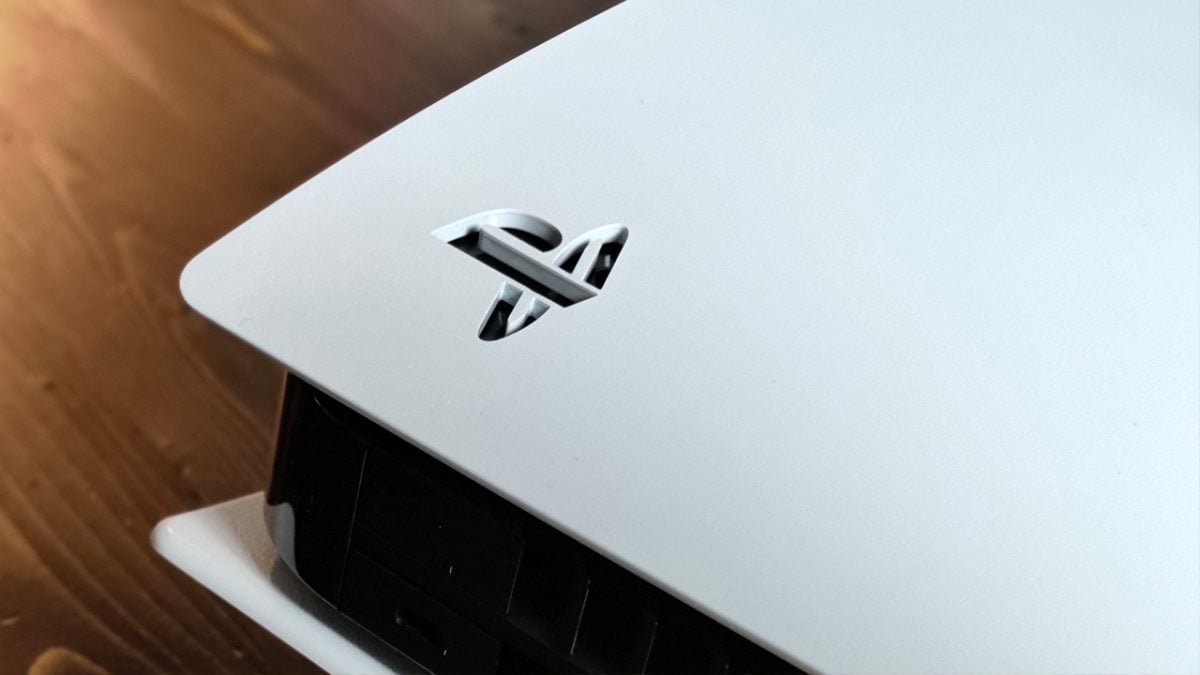The term “PlayStation” has taken on its own free real estate in the minds of gamers. The beaked, trifecta of a logo is familiar enough to represent a modern image of consoles – and accomplished this feat for almost three decades and counting. For Sony, what began as an entertainment venture over the 90’s later turned into an effort to redefine escapism when the world needed it most. Across five generations of consoles, this immersion from each connected with consumers beyond a well-acted scene or spectacles. Some of these became all too familiar, with certain levels and characters becoming part of what home means. This is where Sony has become an extension with its trademark consoles, which in turn gave birth to multiple franchises including Crash Bandicoot, God of War, Uncharted and Ratchet & Clank. PlayStation’s willingness to create new universes has also mimicked that of Marvel by giving players someone to identify with (and someone to have fun with).
But what propelled PlayStation was having been with gamers across their best memories. Its impact deepened by putting power into the hands of gamers to be characters greater than themselves. Sony’s latest PlayStation 5 console marks the return of a familiar feeling by opening the door for more of these awe-inspiring moments. Its quality only improved with big-budget storytelling, cloaked in a deep level of interactivity which never leaves players behind. From protecting a young girl from zombies, to giving an exhausted treasure hunter a warm send-off or mashing DualShocks triggers to help a demigod out. Through an evolution in cinematic storytelling, the bond for PlayStation’s characters sparked from fun. But as they became affected with every adventure, a part of players felt the same emotional impacts. Our favourite characters, though aged with technology, continue to be supported by fans who have literally looked over their shoulders from the start. Of course, the sold-out demand for the PS5 is a show of this dedication from gamers. Amid a brand new launch, players dream less about entering the next generation of games, as much as they want to follow where their characters go next. To mark another future with the PlayStation 5, CGM revisits the past consoles which made it.
Before reading, you might want to check out CGM’s The Road to Xbox Series X for Microsoft’s parallel journey from 2000-2020.
1994 – 2006: PlayStation begins!
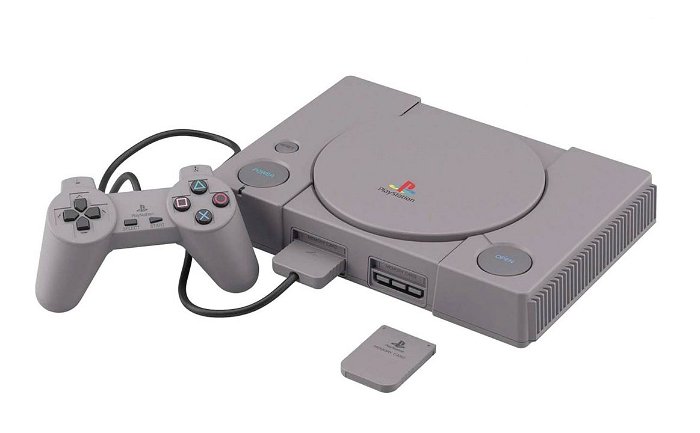
Like how Xbox was inspired by PlayStation, it’s almost baffling to say the same happened for Sony and Nintendo. But the early idea for Sony’s first console was actually born in 1988, when the corporation was contracted to build a CD expansion for the Super NES console. Nintendo already partnered with Sony for producing the SNES’ sound card previously, making them an easy fit to manufacture new game parts. But as Sony developed the SNES components, they also gained a knact for console manufacturing. For years, Sony had also wanted to join the market after seeing consumers renew their interest in tech through video games. The interest grew enough for Sony to make the move when Nintendo’s Game Boy and NES dominated the market. This gave Sony an idea for a console which would run both SNES and some exclusive CD-ROM games. The two-in-one system was fittingly called PlayStation and was geared as a definitive gaming experience for its generation.
According to PushSquare, Sony’s bold plan would only happen after the SNES gets the CD-ROM drive. At CES 1991, Sony made the SNES’ expansion public with an announcement detailing their partnership with Nintendo and teased its PlayStation concept. But in one of the biggest acts of war in the video game industry, Nintendo announced a day after it would be cutting ties with Sony and receive the SNES expansion with Philips instead. With Sony left without support, the company lost a major gateway into video games. However, the PlayStation console was already thought-out with a surprising number of concepts and funds (which even birthed a prototype system). It was Sony’s enthusiasm to build the PlayStation which put them at the point of no return. The company was able to make use of Nintendo’s CD ROM expansion for their own console. Executive Ken Kutaragi, known as “the Father of PlayStation,” pitched the PlayStation to Sony then-president Norio Ohga. The goal? To follow their interests in gaming on their own terms while pushing 3D hardware beyond current 16-bit pixels.
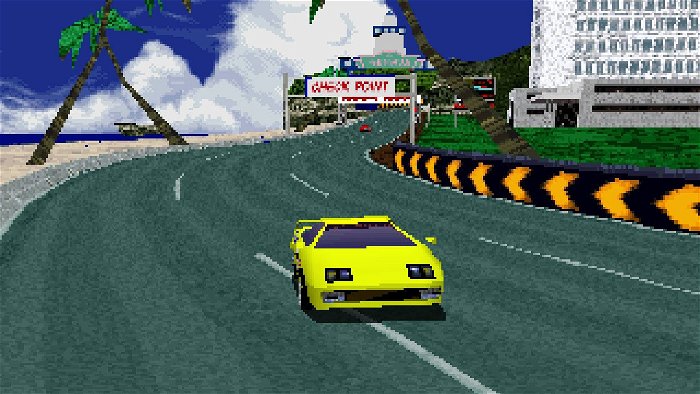
In 1994, Sony caved into the idea of joining the gaming business. The PlayStation received funding and its own department called Sony Computer Entertainment to develop it. Its games would also render 3D worlds in real-time, going against a trend of recorded choose-your-own-adventure games. This helped fuel Sony’s focus for fully 3D experiences up to the PlayStation 5, while giving gamers full control of characters. As SCE continued putting together the PlayStation’s specs, competitors including Sega were worried enough to make the jump for 3D games. This even spurred Sega into making the Saturn console, which would compete with PlayStation and introduce live 3D graphics. Interestingly, 3D games were reserved for larger arcade machines. Namco was a leading developer for these 3D based games, while they allied with Sony to bring the same graphics at home. Namco managed to shrink its hit arcade game Ridge Racer, which became one of the PlayStation’s launch titles.
Much of the PlayStation’s first-party studios were still non existent. The company reached out to English game devs Psygnosis (now the modern SCE Liverpool) for help with creating more launch titles. For PlayStation, it became a breakthrough when Psygnosis saw the prototype. This was then development lead Ian Hetherington clashed with Sony to improve the system. Eventually, Psygnosis was allowed to bring in other connections and beef-up PlayStation with additional PC hardware. The PS1 development became less expensive and faster. Its PC-based parts also made it easier for studios to create launch titles with and fostered creative freedom that wasn’t common from Nintendo or Sega. Sony’s support grew from the industry ahead of its launch and even created the company’s developer-friendly practices in the future.
Sony’s PlayStation launched for the first time in Japan on December 3, 1994. It later released in North America on September 9, 1995 with 11 launch titles including Rayman, Wipeout, Ridge Racer, Street Fighter: The Movie and NBA Jam. For Day One buyers, the lineup’s focus on 3D games gave a solid impression on what would come. Games like Battle Arena Toshinden broke the 2D barrier for fighters at home, showing fully-animated characters duking it out in a rotating map. This was the early potential PlayStation had for next generation games across the 90’s. The focus would only become clearer with more third-party studios partnering with Sony. Konami, Capcom and Namco became three major teams which funneled titles into the PlayStation.
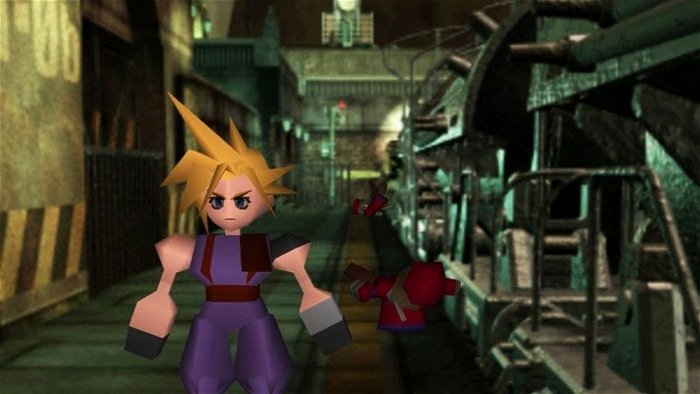
Though competitors also released similar titles, consumers flocked to PlayStation for its performance in games like Resident Evil, Tomb Raider, the early Tekken series. This was where the system satisfied Sony’s revenge against competitors and existed alongside the Nintendo 64 and Sega Saturn. Little did consumers know, PlayStation became a testing bed for some of gaming’s most iconic characters. Crash Bandicoot debuted exclusively as Naughty Dog’s first in many hits with Sony, later growing into a smash franchise. Gran Turismo launched in 1997 as Sony’s own high-fidelity 3D racing game following their success with Ridge Racer. Surprisingly, the racing game would also become the PS1’s best selling game of all time. Spyro the Dragon put 3D platforming at center-stage with its immersive worlds-within-worlds design by Insomniac Games. Fortunately, Spyro‘s formula would help in building the Ratchet & Clank series as Insomniac eagerly followed Sony into their second console.
But PlayStation’s habit for exclusives took a massive climb through their loyal partnerships with Square Enix and Konami. In 1997, the console would be home to one of the most influential video games ever made. It followed a young pointy-haired mercenary named Cloud Strife, who brandished a giant sword and fought against a corrupt megacorporation. Called Final Fantasy VII, its combination of real-time 3D graphics and rich movie-quality storytelling gave Sony a permanent formula. At the time, critics also gave the PlayStation hardware credit for delivering some of the best-looking visuals ever made. The PlayStation also found its killer app, selling 10 million copies worldwide and put more systems in households. Sony’s revenge was sweet, as Final Fantasy VII was scrapped for the N64 for its expensive cartridges and lack of space (like a CD-ROM). In turn, the game had been monumental for normalizing console exclusives – a trend which still continues into the ninth generation.

The console somehow blew more minds in 1998, as Hideo Kojima made the finishing touches for Metal Gear Solid. Despite it being a sequel to older 16-bit installments, the game broke 3D territory and took every advantage of the PlayStation’s hardware (down to that Psycho Mantis fight). For Kojima, the PlayStation was his tool for realizing a stealth game with intricate cinematography. It was also an action-platformer which made use of 3D environments in smart ways for players. Using real-time cutscenes and other unexpected goodies, Metal Gear Solid pushed the boundaries for storytelling while cementing stealth games for life. Longer cutscenes drew Metal Gear Solid out into a different kind of game; one which sucked players into a deep story. Down the road, PlayStation would later use Kojima’s strategy of game-meets-movie for their own exclusives like God of War, Uncharted and The Last of Us. Critics took a standing ovation for PlayStation’s second killer app, which put the system up as a machine which could play like Nintendo and entertain like VHS. Sales skyrocketed for Sony’s debut console and further gave consumers a value for choosing specific consoles.
Demand for the PlayStation also spawned the PS One on July 7, 2000, which slimmed the hardware down into an extremely compact shape with a CD-ROM drive. It was also Sony’s chance to officially number the console to avoid confusion for its upcoming PlayStation 2 system. By then, buyers would have a full library of games accumulated from the mid-90’s near the end of its life cycle. A bonus Combo pack have the PS One a five-inch screen for a more portable experience if players were near an AV outlet.

Gamers fell in love with Sony, as their PlayStation console stood on its own legs and pushed the gaming industry forward. Developers were able to push the medium forward by using the PS hardware for deeper levels of storytelling in games. But this was just the beginning for PlayStation, who accumulated over 112 million in lifetime console sales. Sony’s video game debut worked to convince fans of its exclusives for its next iteration, while sustaining a vast library of superior third party games powered with higher end hardware. Eventually, the company’s second console would quickly overtake the PS1 while offering full backwards compatibility. Sony Computer Entertainment, along with its first-party SIE studios and partnered third-parties, would stick together to capitalize from their success. PlayStation was pulled from store shelves in 2006, marking the end of their first era.
2000 – 2013: PlayStation 2 hits home.

Shortly after the original PlayStation launched in 1994, Sony was actually drafting their plans for an improved console. Features which didn’t make the first cut included a brand new DVD drive which would render more data than the pioneering CD-ROM format. This console would also be able to run PlayStation games using backwards compatibility, while it would feature an ethernet connection for the first time. Interestingly, the DVD system would also run both games and movies to turn Sony’s second console into an all-in one entertainment system. Of course, its most valuable feature came from its upgraded memory system which could store megabytes of information across different games (and allow instant save transfers). Graphics hardware also received a much-needed upgrade, which would use a custom synthesizer to render PC-based visuals. For developers, this continued a relationship of creating games in however method they wanted. Third-party games would also naturally optimize with the new PlayStation’s hardware, running graphics with smooth real-time buffering at 150 MHz.

The PlayStation 2 would be revealed as the next console to hit the sixth generation of games, just five years into the PS1’s life cycle. Though the original console continued to produce content until 2006. By then, the PS2 quickly overtook it by essentially being two consoles in one. Its backwards compatibility also meant players could transfer their entire libraries over, while expanding it with PS2 games. This would create a strong selection of games to play on Day One and draw consumers away from the competing Gamecube and Xbox. Without any reservations, Sony went ahead with its official launch across 2000. Going by its initial focus, Sony offered more 3D games to show off the console’s sharper fidelity. Titles including TimeSplitters, Unreal Tournament and Armored Core 2 were a few that showed off the DualShock 2’s dual analog sticks (which became a staple after it was sold as a PS1 add-on). Street Fighter EX3, Tekken Tag Tournament and Dynasty Warriors 2 took fighting and beat-em-up games into fully-immersive environments with bigger spaces. The PS2 was also home to Rockstar Games’ Midnight Club, which would spawn into a series and help the studio out for its first 3D open-world crime game.
Many gamers adopted the PS2 as their main driver across the 2000’s and were given strong first-party support from studios. But Sony’s focus on introducing new original games also made the PlayStation 2 one of the company’s most important eras. This was also when franchises including Ratchet & Clank, God of War, Sly Cooper, Jak & Daxter and Kingdom Hearts all started. Each game also continued to their own acclaim, sparking a trilogy of sequels which would keep PS2 owners happy across the generation. These were also franchises which overtook competitors, as Nintendo continued delivering on familiar universes through the Gamecube. Gamers went to the PS2 for a refreshing start with new universes, which also birthed Killzone and Shadow of the Colossus.

The pivotal success from PlayStation’s Final Fantasy VII prompted Square (modern day Square Enix) to spawn Final Fantasy X, which finally introduced a completely 3D world. Like a dream, players were given the first true Final Fantasy game which played out like a Studio Ghibli odyssey. This continued with Final Fantasy X-2, which implemented 3D platforming to access new areas and played closer to Sony’s formula for vast exploration in wider planes. The game also helped push the PS2’s affinity to render shadows, which bounced off characters from off-screen light sources. Square Enix would go on to produce the landmark exclusives Kingdom Hearts and Kingdom Hearts II, which did plenty to boost console sales at the prospect of mixing Disney and Final Fantasy together. Unlike most games mastering 3D visuals, Sony had hoped to do more with their PC-based engines with the help of first-party studios. Other studios including Rockstar Games rose to power, using the PS2 hardware for a soft reboot of Grand Theft Auto. Players sunk more time into their consoles for GTA III, while more memories flowed from Vice City and San Andreas. Though they weren’t exclusives, the PlayStation 2 helped popularize the open-world genre with hardware to bring a full 3D city to life.
But in history repeating itself, Hideo Kojima worked with Konami to bring two of the PS2’s biggest exclusives. Metal Gear Solid 2 was another game which built on the groundbreaking feats of its original. Players basked their eyes on a totally different graphics engine which combined higher resolutions with dynamic lighting. Characters could finally become more lifelike and use facial expressions to communicate with players in fourth-wall breaking cutscenes. Gamepaly was also improved with the DualShock 2, giving Kojima every opportunity to throw a surprise at players along their trip in the Big Shell. The game could also be bigger than its predecessor while actually connected several large maps together seamlessly. It’s worth noting Konami extended the first Metal Gear Solid game to Nintendo and remade it for the Gamecube using the same engine and updated controls from MGS2. Despite this, Konami stayed loyal to Sony and kept them a step ahead with another hit exclusive: Metal Gear Solid 3: Snake Eater. It managed to break bigger barriers with what the PS2 could offer. MGS3 not only delivered on a movie-quality narrative, but kept players invested in a stealth-action adventure only the PS2 could have accomplished at the time.
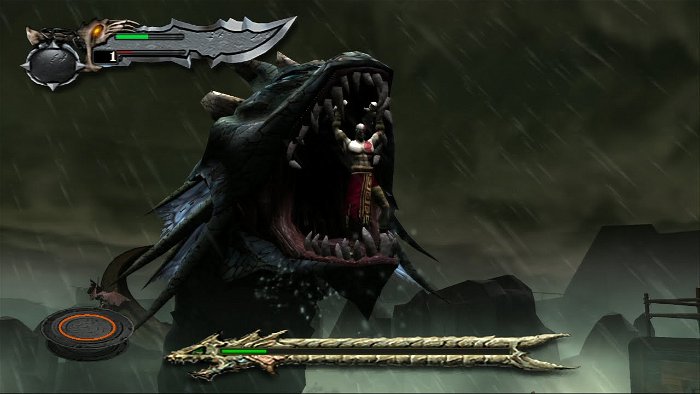
Where the Xbox found its champion in Master Chief, Sony had created a god-killer with really sharp blades. In 2005, God of War took PS2 owners off their feet with an incredibly ambitious dive into Greek mythology. But unlike other fantasy games, Sony had used this universe to deliver a refined hack-and-slash experience with the same cinematic formula. The result was nothing short of an entertaining package which pushed the boundaries of a next-generation game. Players didn’t just bathe in Kratos’ rage as he trampled through massive 3D behemoths. They also experienced a buttery smooth 60 frames per second, which somehow proved the PS2 didn’t compromise with graphics and performance. God of War put the PlayStation 2 on a bigger pedestal, as Kratos became a breakout poster boy for years to come. Sony would later outdo themselves again with God of War II and somehow improved on visuals and performance with seven year-old hardware.
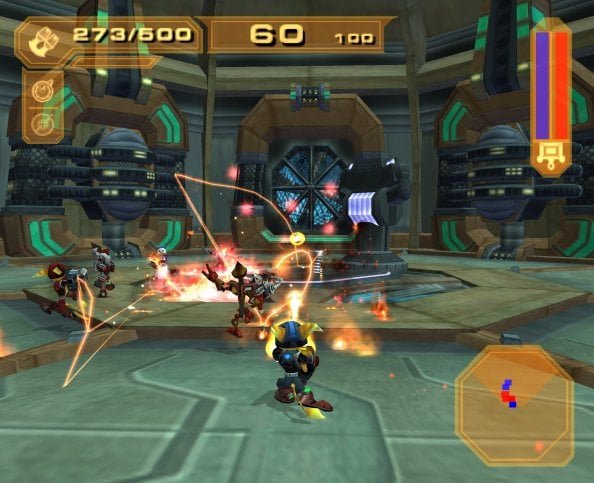
2005 was an especially bigger year for Sony, with Sly 3: Honor Among Thieves completing another hallmark trilogy. Sly Cooper had been the PlayStation 2’s answer to stealth games as the genre was revitalized with Metal Gear Solid. Third-party studios helped to expand stealth in a similar fashion by bringing Splinter Cell: Pandora Tomorrow and Chaos Theory. For PS2 owners, it became easier to bat eyes from other consoles as they continued to receive every third-party game. Like God of War, Sony had made its own formula for enticing exclusives. God of War, Ratchet & Clank and Sly Cooper all ran with high frame rates, real-time cinematics and a smooth graphics engine. This helped to normalize fully-3D titles, putting a nail in the coffin for polygon visuals and 32-bit formats. In the same year, Ratchet Deadlocked was released as another exclusive. Like other Sony characters, the Lombax had been through a trilogy of smash hits which were unique for PS2 players. His own brand of third-person shooter evolved within a single console and threw players into a wacky universe and preceded the days of Mass Effect. Of course, Ratchet & Clank was cemented as another iconic poster franchise from Sony. It also became Insomniac Games’ source of first-party titles across its next three consoles.
PlayStation 2 gave its all to consumers in 2005 (four words: Shadow of the Colossus). The console continued to shine brighter in homes, with the original Guitar Hero game released exclusively. Its special guitar peripheral would specifically plug into the console, giving PS2 another unique edge over other competitors. The experience of physically controlling a concert with fire chords started another frenzy for the PlayStation 2 console. This would help gamers fall in love with the rhythm genre again, while spurring an interest for simulation-based controllers. Sony had already experimented with new peripherals, starting with the EyeToy in 2003. It practically became a webcam which used AR technology for physical games. EyeToy saw its own decent amount of games, but continued to stay in the shadow of Sony’s AAA exclusives until the end of the PS2 life cycle. Ultimately, it started to become overshadowed by its next hardware iteration after it launched in 2006. EA continued supporting the system to a ridiculously narrow pipeline of sports games, including FIFA 14 which became one of the last games ever produced for PS2.
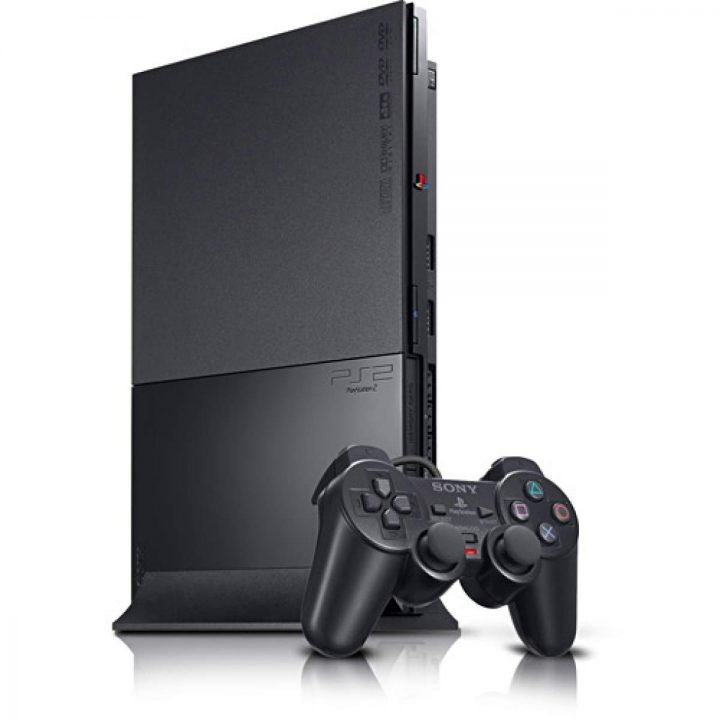
It’s worth remembering the PlayStation 2 saw one of the biggest diets in 2004. A slimmer version managed to pack the same powerful hardware into an unrecognizable form factor. The slimmer console also kept its disc drive and fully-sized DualShock ports, while it was friendlier to store as an appliance. Like its bigger brother, the PS2 slim also matched top-of-the-line DVD players which were just as sleek.
The PlayStation 2 opened a door for fully-3D worlds, pushed forward by Sony’s earliest franchises. This gave the console one of the biggest libraries for exclusives while it held a special place for young gamers over the 2000’s. The console also showed the industry how to produce highly-entertaining games which transcended thrills from the best Hollywood films. Sony Computer Entertainment became iconic from their numerous splash screens before players jumped into new worlds. Its third-party support only beefed-up the PS2’s already-expansive library, so much that its Greatest Hits line would continue collecting dust in homes today. Like the original PlayStation, Sony had a new launching point for a new generation of gaming. The PlayStation 2 ended circulation on January 4, 2013 as the highest selling console of all time past 155 million owners.
2006 – 2016: PlayStation 3 sails smoothly into modern gaming

With most of Sony’s hit franchises established, the PlayStation 3 only had to produce sequels which improved with HD technology. Sony would start building their console with an HDMI port with its traditional TV cables. The high-fidelity visuals needed a bigger home beyond DVDs and adopted the Blu Ray disc for physical games. These extended formats would translate to the PS3’s new focus of adding lifelike visuals over 3D objects. Sony would add in a ridiculously powerful 3.2 GHz processor to handle dozens of real-time animations at once. A custom 550MHz GPU from Nvidia would let developers throw details including fabric, sun rays and bruises over characters. The graphics card also gave games unparalleled motion-captured sequences, making the PlayStation 3’s library more cinematic than ever.
The earliest signs of life for the PS3 started as early as 2001, just as Sony focused on securing its franchises. Its openness to cooperate with third-parties became crucial, with IBM and Toshiba contributing specs to make the console miles ahead of the PS2. According to lead designer Mark Cerny in 2013, Sony had pooled too many resources into the PS3’s hardware over software. This became a challenge for creating an affordable system on Day One. SIE’s American studio was also spearheading much of the PS3’s build, making its launch titles a tad bit too domestic. Sony’s international developers soon became overlooked, which created a hurdle once PlayStation would pay attention to software. “We were thinking about our own game titles for SCEA [Sony Computer Entertainment America] in the U.S., not the platform at all,” Cerny told VentureBeat.
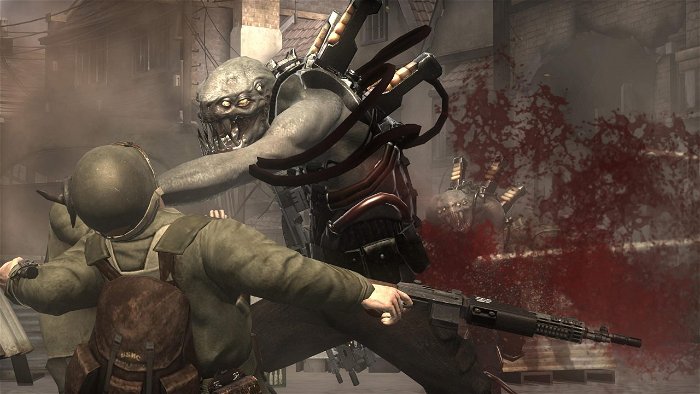
Unlike the chemistry between Sony and its loyal studios before, the PlayStation 3’s dedicated hardware meant games were more difficult to produce. This, from Cerny’s view, gave players a sub-par launch lineup. For Sony, they depended on their internal developers to draft a mere couple of games such as Resistance: Fall of Man, Untold Legends: Dark Kingdom and Genji: Days of the Blade. Activision became a larger help through third-party titles with Call of Duty 3, Marvel’s Ultimate Alliance and Tony Hawk’s Project 8 which injected some much-needed variety into a somewhat stale impression of next gen for gamers. Only NBA 07, Ridge Racer 7 and Ultimate Alliance supported 1080p and became a step back in time for Sony who wanted to raise the bar.
The PlayStation 3 was first introduced with its hilarious “boomerang” aesthetic back at E3 2005. It generated hype for Hideo Kojima’s much-anticipated Metal Gear Solid 4 which would capture the best parts of Snake Eater and provide a present-day action game for the masses. It was also the company’s padding for excited consumers ahead of a slow start for PS3. Sony also touted the PS3’s built-in internet connections, which brought Wi-Fi for the first time in a game system (putting them a step ahead of competitors). The PS3 also tripled-down on its multimedia capabilities, adding in a full internet browser and USB support for watching movies. The console was finally launched to a frenzy on November 17, 2006 with its limited launch library. Sony fans remained faithful to PlayStation 3’s upcoming first-party titles; the earliest of which would trickle next year.
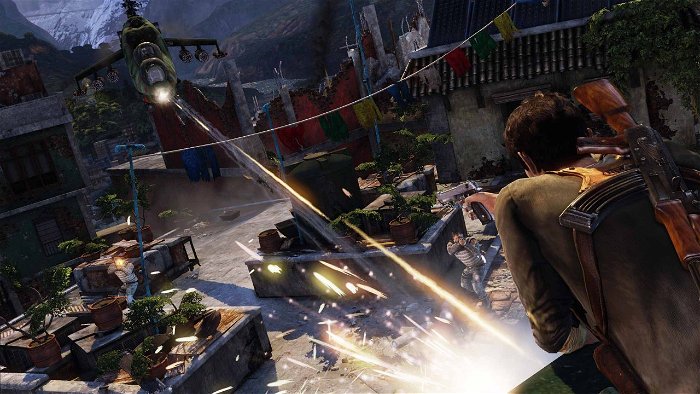
This was when the PS3 started to live up to its name from 2007 and 2008. Exclusives like Lair and Heavenly Sword demonstrated the PS3’s ability to project massive armies across a gleaming battlefield for fantasy games. Both were also particular with showing off how future games can implement more physics as players reacted to destructive environments. Given the PS3’s extra room for caching, the console could cause a messy in-game situation without freezes or lagging. This also meant making real-time 3D games were easier for developers and sparked a race for the best-looking title on PS3. The cinematography also allowed for motion-capture techniques to be applied in games. This is what helped Naughty Dog produce a Hollywood-style action game around a young treasure hunter on the search for El Dorado. Uncharted Drake’s Fortune released to an impressive scale for third-person shooters and helped popularize cover-based mechanics with Gears of War. Uncharted would spawn a franchise while the original game would become a major killer app for the PlayStation 3.
Whereas Xbox would launch Halo 3: ODST in 2009, Sony would clap back with Uncharted 2: Among Thieves. Considered the best in the series, it took PlayStation 3 users by storm and aged gracefully into the next generation. An intricate Hollywood-level production was in play once again, while the graphics aged gracefully when it released in The Nathan Drake Collection on PS4. Its sequel, Uncharted 3: Drake’s Deception would turn up Naughty Dog’s world-building scale for explorers. Naughty Dog would go all-in on “interactive tragedy” with The Last of Us. With a large whirlwind of Oscar-worthy performances, emotional journey and refined gameplay, The Last of Us became the PlayStation 3’s magnum opus. It significantly boosted console sales for players looking to experience Ellie and Joel’s plight across a zombie-infested America. Its detailed world painted nature reclaiming large skyscrapers and littered interactivity in new ways. This also gave players a direct glimpse into how next-generation games would look as hardware continued to be wrung dry. In hindsight, Naughty Dog had created the first next-gen game for PlayStation 4.
With traction picking up on the PS3’s next-gen chops, other studios including Insomniac Games were just about ready to launch the next Ratchet & Clank Future series. Starting with Tools of Destruction, it echoed the same ambitions as Naughty Dog in delivering a Pixar-like film that could be played. PS3 owners received a decent amount of sequels, but gradually lost what made Ratchet & Clank special as it sunk into shooter-territory. Smaller games including Full Frontal Assault and All 4 One were some of Sony’s exclusives which weren’t immune from mediocrity. Sly Cooper studio Sucker Punch Productions closed the book on their iconic PS2 trilogy, but focused on a fresh open-world superhero game. Starring new bald protagonist Cole McGrath, Infamous and Infamous 2 would add superheroes into Sony’s portfolio of genres. Its mature take on comic-book like narratives were boiled down to some addicting traversal mechanics and cool electric powers.

Because Sony had reached the same levels of animation as film studios, the PlayStation 3 would become a symbolic theatre which consistently churned out big-budget games. It harnessed the gameplay from its PlayStation 2 hits, while using newer hardware to deepen their substance. Hideo Kojima’s imagination would only be unchained with newer hardware and proved Sony’s point with Metal Gear Solid 4: Guns of the Patriots. In true exclusivity-vibes, the game would capture the magic of Sons of Liberty and Snake Eater (games which literally incorporated the PS2’s features in the plot). Metal Gear Solid 4 would also become notorious for being too cinematic, giving players long pauses in stealth action to watch fully-produced movie scenes. But the formula ultimately summarized the PlayStation 3’s status as a must-buy entertainment system. Naked Snake’s last adventure was also deemed near-perfect for how it translated over Sony’s premium hardware. As best described by Kotaku’s Stephen Totilo, Metal Gear Solid 4 was a perfect blend of storytelling and technological feat that played out like “an interactive tragedy.” Developers would continue following Kojima’s example towards bringing more of these “tragic” narratives in The Last of Us, Uncharted 4 and God of War (2018).
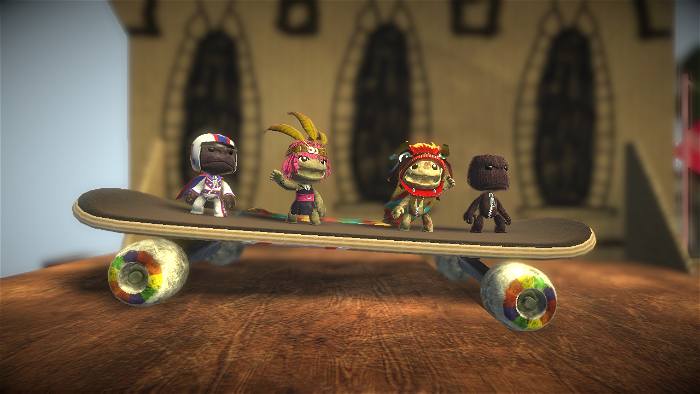
Months after Kojima’s return on the PS3, Sony Computer Entertainment released platformer LittleBigPlanet. Its simple concept of user-generated content and 2D platforming became a refreshing hit from violent releases. A departure from action-oriented IPs, Sony had made its first truly wholesome franchise that put Sackboy (and his detailed threads) in a new poster spotlight for PlayStation. Thanks to a non-stop development cycle by Insomniac Games, it would release Resistance 2 and bring the original launch title’s shortcomings to a full circle. Sony also made some design changes to put Resistance 2 in a trend of fast-paced first person shooters. With Call of Duty 4: Modern Warfare sending the FPS genre into overdrive, players continued finding new purpose in the PlayStation 3. It became clear the generation was headed towards a genre-change, with Fallout 3 also releasing in 2008. The post-apocalyptic RPG also entered gaming’s seventh generation at a perfect time; as an open world FPS which mixed cinematic interactions with the best graphics possible. Gamers living in 2008 continued to have their minds blown with the anticipated launch of Grand Theft Auto IV, which made the PlayStation 3 a somewhat addictive appliance for years to come.

Sony, seeing the public appeal for first-person shooters, looked to Killzone 2 and Killzone 3. While the original PS2 game visualized a muddy run-off-the-mill science fiction FPS, its PS3 sequels would completely reboot the look and feel. Modern shooting controls worked better under its fast-paced cover mechanics. The Helghast sent chills with AI that reacted to player’s hail of bullets through unsurprisingly lifelike visuals from Guerilla Games. The PlayStation 3 took full advantage of Nvidia’s custom GPU to create dynamic fog and realistic light sources. Gamers adopting the 1080p formats were also treated to high levels of detail with motion blur creating a chaotic battlefield. Killzone 3 would beef up its engine using Sony’s seven-year-old hardware, adding detailed snow with natural sun spots. At the weird age of Kinect, Wii and physical peripherals, Killzone 3 would also push its PlayStation Move motion controls and later kept the format for PSVR in future generations.
Where The Last of Us gave the PlayStation 3 a worthy send-off, players would hold onto their consoles a bit longer for God of War 3. The anticipated sequel for the 2007 classic was given a grittier detail using the console’s hardware. The result was a clear vision of Kratos taking his revenge against the Greek gods after a turbulent adventure. Like the PS3’s streak of exclusives, God of War 3 would add bigger scripted moments with its traditional hack-and-slash flow. Critics also gave the game a standing ovation for expanding the scope of Ancient Greece, so much that its levels felt like entire self-contained worlds. Little did players know, Kratos would slumber for years before rebooting into a next-gen Norse realm. God of War 3 joined the Greatest Hits collection, sustaining its library near the end of its life cycle in 2016.
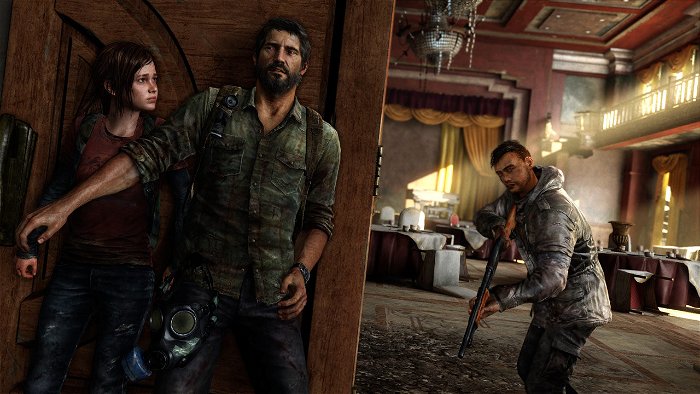
In true console fashion, the PlayStation 3 saw two more diets over its lifespan. While the Day One version gave owners a premium, elegant and exotic finish, the second PS3 went back to its past designs and sported an all-black matte finish. It was also sleeker, giving late buyers extra appliance space in their homes. The third upgrade slimmed the system down further while it brought back the original’s glossy finish and a sliding CD tray door to save costs. The console was finally taken out of commission as Sony brought their PlayStation 4 into existence in 2013 (which hilariously was when PS2’s ended circulation as well). The PlayStation 3 ended with over 87 million lifetime sales worldwide, making it the lowest-grossing Sony home console to date.
2013 – Present: PlayStation 4 tells a different story

Plans for the PlayStation 4 console were in motion when the PS3 was three years old. Its first priority was to avoid another slow start, which put the Xbox 360 ahead by 10 million units. Instead of huddling away from third-party developers for designing the PS4, Sony would echo their early days and gather help. According to TechRadar, Sony reached out to Destiny and ex-Halo studio Bungie for the Dualshock 4’s design. The goal was to make a wireless controller which would be tailored for shooters after the genre blew up in the previous generation. Its features, which included textured controller grips and a caved-in analog surface and gun-style triggers would feel more like an extension for quick fingers.
At the dawn of streaming and content creation, Sony would included its surprisingly-handy Share button for instantly turning gameplay into videos. Sony also reached out to AMD for its custom Radeon graphics chip, which came at an upgraded 800MHz (making it ready to remaster past PS3 titles with struggling performance). AMD also supplied its powerful 86-bit architecture “Jaguar” core with over 1.6GHz clock speeds. This gave the PS4 an ability to handle different processes easier, including a side bar for tools, faster downloads on the side and suspending apps. 8GB of memory was given, while it gave the system enough extra room for Rest Mode, which could freeze the PS4’s state for months and resume play where it left off. This time, Sony had the drop on a precise launch date. The company sent over their PS4 dev kits early for studios to study and build launch titles on. Developers could also tailor their PC-based projects to the PS4, especially for exclusives directly optimized for it.
Just as Sly Cooper: Thieves in Time was released on the PS3, Sony would reveal the PlayStation 4 at a special conference on February 2013. It would be a culmination of Sony’s beloved franchises, each taking a step into cutting-edge experiences. Naughty Dog’s The Last of Us would set a new standard for PlayStation exclusives on the new system. Every release would follow a similar format of narrative-driven epics, connected together by traditional gameplay (much of which was established in the PlayStation 2 days). Remember Sony’s constant focus of mixing movies and games? The PlayStation 4’s hardware would be able to finally create sequels which took on The Last of Us‘ approach (see God of War and Uncharted 4).
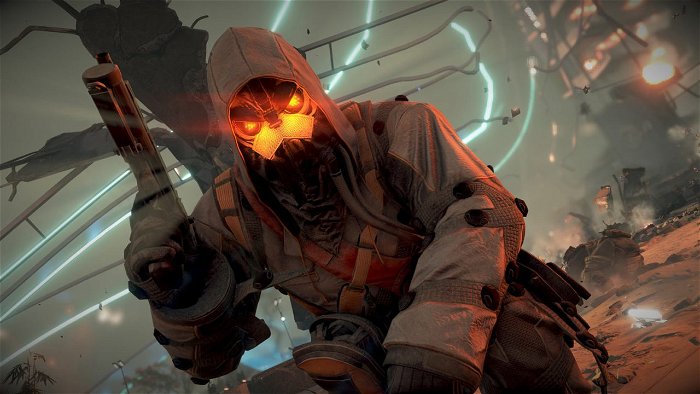
With some high expectations from gamers, the PlayStation 4 was launched at a surprisingly-generous $399 USD on November 15, 2013 worldwide. In a first, Chinese gamers could also buy the system in a joint trade deal with Sony. This significantly increased the PS4’s sales, fueled by international popularity and demand for a slice of Sony’s exclusive pie. Sony’s 21 launch titles were also bolstered by an even bigger majority of third-party developers. Seeing the potential in small-time indie studios, Sony would include them on the lineup for the first time. The industry, as it did in the 90’s, rekindled a mutual relationship with Sony on Day One.
Games including Killzone Shadow Fall, Escape Plan, Knack and Resogun were a few hardware-exclusive PS4 titles which demonstrated its DualShock features. They also gave gamers a strong impression of high-fidelity graphics at UHD and motion-capture characters that felt a tid bit too real. Assassin’s Creed IV Black Flag would offer a bigger open-world scale that worked naturally with the PS4’s extra room for performance. Battlefield 4 could offer full-scale combat and turn massive buildings into rubble without the PS4 breaking a sweat. Interestingly, Injustice: Gods Among Us became one of the first remasters for the system. Its “Ultimate” Edition was the first of many games to come with graphical enhancements and no more burps in performance. Day One players had plenty to do with Call of Duty Ghosts, which would become the first truly next-gen installment in recent memory.
As Sony’s first-party developers crunched away at the PS4’s first original exclusives, remasters continued to dominate most of its first year. The promises of a next-generation Grand Theft Auto V with major performance changes was enticing for PS4 skeptics. An idea to remaster the entire Uncharted trilogy was Sony’s answer to Xbox’s wildly ambitious Halo: The Master Chief Collection. Naughty Dog’s smash PS3 hit The Last of Us would get its own remaster, giving the large narrative more space to breathe. Like its other PS3 exclusives, The Last of Us Remastered would come with 60 frames per second performance; one of next-generation gaming’s biggest gimmicks. This soon gave third-party studios an opportunity to make appearances on the PS4 and make fixes to their older titles. Tomb Raider: Definitive Edition would give new Lara a proper home after suffering from performance dips on the PS3. Metro Redux would use a few elements from their upcoming sequel and upscale the first two games for UHD.

The remastered-craze from developers would come with heavy-hitters in 2015, with remasters for L.A. Noire, Devil May Cry 4, Borderlands, Final Fantasy X/X-2 and Gravity Rush all coming with their fullest potential over PS4. But its major killer-app came with Sony’s own remaster of God of War 3, giving the PS3 adventure smoother performance in fights and upscaled graphics which made it look like a next-gen native app. It would feature additional animations and some control improvements with the DualShock 4 while the PS4’s upgrades could properly project God of War 3‘s scale with UHD. This significantly boosted sales and interest for next-gen consoles, though players would have to repurchase their games (a practice which would gradually be looked down upon leading to the PlayStation 5’s launch).
Remasters would do plenty to keep PS4 owners happy, while exclusives including Infamous: Second Son and Until Dawn would trickle down. But the horror genre would find a new life over the current generations of systems. The PS4 became a trendsetter of motion capture, photorealism and levels which could transform in real-time. These technological aspects would combine for movie-quality scares first demonstrated by Until Dawn. But in another generation for PlayStation, it became a surprising entry for Hideo Kojima. Working with horror director Guillermo del Toro, the two would create an interactive horror experience like no other. It would use the PS4’s full power to put players in a sublime, supernatural nightmare.

Simply called P.T., it became monumental in bridging games with Hollywood even further. Players would walk around an empty house, which seamlessly changed before their eyes without loading screens. They were unknowingly followed by a spirit, who was given a terrifyingly accurate detail with the PS4’s tech. A bloodied fetus was designed to chillingly disgusting degrees for players to see before they were randomly attacked by the spirit. Kojima’s create drive to scare viewers and break the fourth-wall were a combination for sheer horror. P.T. would send two messages: Motion capture could instantly turn celebrities into game characters and playable horror movies are now possible. This was one of the PS4’s biggest killer apps, which ironically was a free demo. Its bigger plot twist came from P.T.’s real purpose: a playable teaser for the highly anticipated Silent Hills game.
Sadly, Kojima and Konami had a fallout and the demo was removed to the controversy of players. In an insult to injury, Silent Hills was cancelled. Since then, games including Resident Evil, Outlast and Blair Witch would try to pick up where P.T. left off and deliver realistic terror. Its exclusivity over the PS4 bolstered a big interest in the system, to degrees where a market sold systems with P.T. still installed. Kojima’s resolve continued into starting a brand new studio, taking del Toro and Norman Reedus with him for an original game. Called Death Stranding, it would break new technical bounds using the PS4 hardware. It also told a unique, cinematic narrative with some fourth-wall breaking elements and motion captured characters to deliver emotions. Death Stranding would become a timed-exclusive for the PS4 in 2019 to another standing ovation from fans, new players and critics. Kojima was a bridge for Sony and Konami’s relationship since the first PlayStation, though Kojima Productions would continue onwards without Metal Gear Solid or other IPs. For strong skeptics, Death Stranding would continue to cement the PS4’s legitimacy for telling new narratives beyond traditional media.

Of course, not all Sony exclusives would move mountains. High hopes were given for Ready at Dawn for The Order: 1886. Its universe was a refreshing take on science-fiction. In an age of cyborg supersoldiers, The Order: 1886 painted a vivid Victorian-era London with steampunk technology. A universe was created with modernized Knights of the Round Table taking on some of fiction’s most popular monsters. But its biggest setback came from leaning too hard into Sony territory. In the balance of movie and games, The Order: 1886 would become too much of a CGI film and not enough interactivity. The third-person shooting segments were only bridges for lengthy cutscenes. The game divided critics and players, who called out Ready at Dawn for its five-hour length and lack of gameplay. But The Order: 1886 would stand as one of the PS4’s biggest tech demos. Developers used a highly-advanced engine which combined photorealistic objects, motion blur and surface particles that was convincing enough as a PlayStation 5 title. It also managed to look like a real movie, complete with widescreen bars and loads of choreographed quick-time events (which The Order set a precedent against). Its near-identical look from its early trailers, to demos and final product also set an industry example; proving downgrades didn’t have to exist. The game launched, sunk and burned on February 20, 2015.
Almost exactly a month later, PS4 owners would be given sleeper-hit Bloodborne which washed away any disappointment with The Order: 1886. FromSoftware would make a rare move to release their next anticipated RPG only on Sony’s system. It would coin the term Soulsborne for games, featuring a near-perfect melee combat system and some of FromSoftware’s most challenging enemies yet. Its Dark Souls trilogy on PS3 immediately gave FromSoftware full credibility for Bloodborne, which gave console owners full bragging rights. The game also went into a new Lovecraftian setting that featured similar European-castle level designs from past games. This instantly appealed to PS4 players, who felt some of P.T.‘s high-fidelity horror seep into an engaging Sony-level story and engaging gameplay. Bloodborne became a near-perfect PS4 game which stuck to its exclusivity and gave owners a reason to keep their HDMI’s plugged.

Sony’s longtime friend, Insomniac Games, would struggle on PS4 with a lack of Ratchet & Clank titles over the current generation. Unlike the PlayStation 2 and PlayStation 3, Insomniac’s most famous characters would only show up once. Its 2016 remake of Ratchet & Clank was actually tied to Sony’s move towards making full-on movies based on franchises. Their most iconic franchise would receive its first film and another exclusive game for PS4. Hilariously, the film tanked while Ratchet & Clank would do the opposite for PS4. The game remade every aspect from its 2002 classic and even stretched the film into a longer definitive experience. Despite the film’s failure, both Sony and Insomniac renewed their wedding vows for each other and bonded along the project’s journey. In 2019, Insomniac Games and Sony tied the knot in a multi-million dollar acquisition. This gave Insomniac games new opportunities to explore different IPs while making exclusive appearances on PlayStation for years to come. It’s worth noting Insomniac would only produce three PS4 games to date. But as the old adage goes: quality over quantity.
Sony, major license owners of a popular superhero, would later tap Insomniac Games for a new exclusive: Marvel’s Spider-Man. Instead of tying directly with other equally-popular films, Insomniac was given full control over the project. This made them free of franchise baggage and were allowed to create their own interpretation of Spider-Man (and reserve movie elements for cosmetics). For a next-gen Spidey game, Insomniac channeled their experiences of Ratchet & Clank‘s rich level design, witty dialogue which conveniently worked and mechanical gadget arsenal. Their Xbox exclusive Sunset Overdrive was a third-person open world game which created an intricate movement system that fit Spider-Man like a glove. As Insomniac’s unique mechanics fell into place, so did creating the Spider-Man game everyone wanted. Sony’s lenience and anti-crunch practices gave Insomniac as much time as needed to produce the game. This gave Marvel’s Spider-Man more than enough time across four years to exercise creativity with new territory using beloved characters. The team looked to another PlayStation 2 best-seller, Spider-Man 2, for perfect web swinging that would use Insomniac’s smooth feedback. New York City was redesigned with breathtaking detail with the PS4’s shaders, giving buildings high-fidelity and the same lifelike quality as its motion-captured characters.

Marvel’s Spider-Man was given a standing ovation when its iconic E3 2017 demo premiered. The game would generate a frenzied-hype for PlayStation 4 consoles as owners prepared ahead. Its status as an exclusive would continue to be unmatched by other competitors, including Nintendo and Xbox who were giving rarer first-party releases. Ultimately, Insomniac Games had returned to the spotlight with their first licensed entry. Players and critics were moved by Spidey’s latest story, which was given the Sony treatment for human-centric dialogue and grounded emotion. Marvel’s Spider-Man launched with worldwide anticipation on September 7, 2018. The result was nothing short of an unforgettable exclusive for the PS4, which was far into its life cycle. It also spawned a new franchise and another iconic poster boy for PlayStation, imbuing the iconic hero with a new purpose in games. Marvel’s Spider-Man would later give Insomniac Games the momentum it needed to draw first blood in next-generation PS5 titles.
2018 sent a double-whammy for PS4 owners through Santa Monica Studios. Sony’s resolve for telling ambitiously-large stories was in full force with a reboot of God of War. But its approach would honor the series’ lore from the main trilogy. It would break into a risky, but welcome change by diving into Norse mythology and leave much of a destroyed Greece behind. This gave director Cory Barlog a fresh start with Kratos, who was now a haunted shell of his former self. The Last of Us became an influence for putting the godly Kratos through real human turmoil. Like Naughty God’s game, God of War would include a child who added emotional heft in a grim world. Kratos became somewhat of an exhausted character players were connected to, but sympathized deeper with. Fans’ jaws dropped at seeing this new version of Kratos, who was also given a new gameplay style that pulled players even closer to the character. Its over-the-shoulder perspective would give the world an even bigger scale than previous God of War game before. This would juxtapose a once-powerful Kratos facing against Norse titans as shown in the E3 2016 demo. Oh, and three words: mystical flying axe.
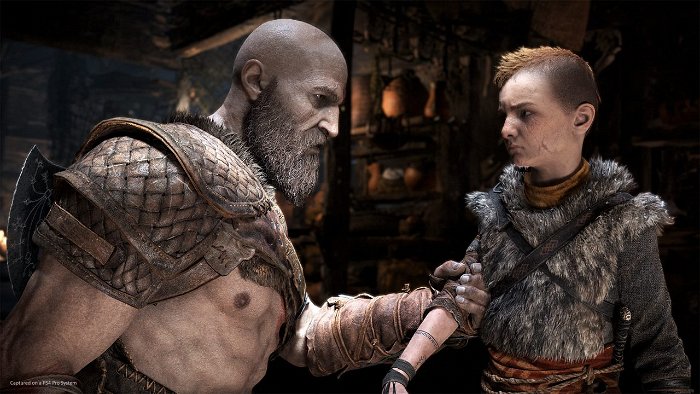
God of War would also take the series into a new, realistic ground which was projected with some of the best looking visuals the PS4 could muster. Ever byte of energy was put towards the game, which even created performance hiccups with aging hardware. But Santa Monica Studios continued to push players through a seamless experience. Its immersion would also be unlike any other world made by Sony, keeping players reeled into God of War without loading screens or camera cuts. The result was a one-shot, 25 hour epic journey completely driven by a simple narrative. Like Logan, it would feel like one last hurrah for Kratos. His son Atreus would pull at fan’s heartstrings with questions about the original trilogy, while each reminder would send fans back into simpler times. God of War was built entirely from the accomplishments set by its PlayStation exclusives of gamer’s past. The game finally released to a thunderous applause on April 20, 2018. As the only franchise title to hit the PS4, it managed to become one of the best selling exclusives of all time. Much to the shock of fans, God of War was the start of a new series that would continue in the next generation.
With a mix of third-party titles, 2018 became the biggest year for the PlayStation 4. Tears drew from a constant release, packed with a Blu-Ray in a plastic case of emotion. Red Dead Redemption 2, Detroit: Become Human, Marvel’s Spider-Man, God of War and a sublime remake of Shadow of the Colossus turned the PS4 into a console that kept on giving (one breakdown at a time).
Naughty Dog’s success with The Last of Us would give them a winning formula for human-centric games. The team ultimately decided to create a next generation sequel for Uncharted, with Nathan Drake ending a 13-year-long saga. Sadly, it would also mark the end of an era for Sony’s treasure hunting series. But Naughty Dog would pull every creative trick in the book for pushing the signature gameplay forward. The cover-based Hollywood action would stay intact, but add a new level of exploration and open world mechanics. Interestingly, Uncharted 4‘s scale over the PS4 actually made it the most adventurous game in the series. This was where players could follow their curiosity into different parts of a level while still moving forward. They could uncover even bigger details off the well-worn path and take in some awesome sights. Naughty Dog would inadvertently create one of their best games, literally combining storytelling elements of The Last of Us with Uncharted‘s core gameplay. This cake mix was baked in a five year long development, with anticipation building up after its 2013 teaser trailer.

Uncharted 4: A Thief’s End would actually take more from The Last of Us for its presentation. At face value, its graphics engine would see an upgrade to show off a believable Nathan Drake. Its tropical details and explorable environment was given a great attention to detail. Old settlements and ruins were mixed in with nature, while wide landscapes would create the series’ biggest levels to date. The story would actually use less characters than its previous entries. The goal was so use more with less, with every character being magnetically drawn to Drake’s psyche. Like Joel, Nathan Drake himself was shown as an aged and exhausted action hero. But he would face an opposite journey of craving the glory days of treasure-hunting. This effectively sent some emotional ripples for Elena, now married and wanting a normal life. Deadly competitors would benefit from Drake’s absence, while long-lost brother Sam would drive the story forward and reveal long-awaited details into his origins. These aspects, combined with The Last of Us‘ gripping life-or-death unpredictability, made Uncharted 4: A Thief’s End a powerful ending to an exciting series.
The game was released to perfection on May 10, 2016. The game was a next-gen evolution for Naughty Dog, who now became a champion for Sony’s boundary-pushing cause. Fans said goodbye to Nathan Drake, but kept him in their hearts and PS4 hard drives with the entire series. Uncharted 4 would foreshadow one more game that would deliver an unforgettable exclusive for PlayStation 4 owners. Like how The Last of Us gave the PS3 a final stand, The Last of Us 2 would do the same for PS4 when video games were needed most. Like a key, the studio would once again give gamers a glimpse into a new, advanced generation.
Naughty Dog heard the cries of millions, who wanted to see more of the engrossing post-apocalyptic utopia in The Last of Us. The team banded together with Sony one again to make a sequel happen. Luckily, Uncharted 4 had also taught Naughty Dog how to make Part 2 even bigger. Its PS4 specs would be pushed to the limits for essentially fitting a PS5 experience into a seven year-old machine. The level design would borrow Uncharted 4‘s nature-soaked themes to show an even more abandoned world in The Last of Us: Part 2. As the world aged, so did Ellie, who was chosen as the new main character. All grown-up, Ellie would become an even more agile character than Joel and put new mechanics on the table. The sequel benefitted from Uncharted 4‘s non-linear design and made it more vastly explorable. For players, it deepened the game’s stealth and combat with more ways to adapt for survival. More characters and enemies could be included on the PlayStation 4 hardware and doubled-down on The Last of Us‘ stakes.
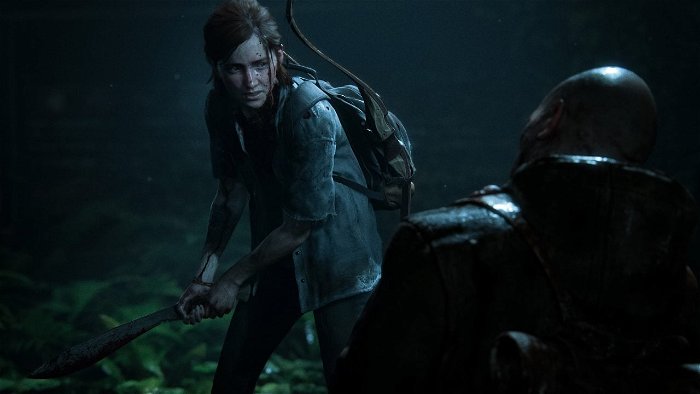
The Last of Us Part 2 would take the most emotional tolls in a Sony game to date. A threat of cordyceps zombies was the least of Ellie’s worries, as the survivors became an even bigger threat. Every character, down to enemies, were given a conscience for survival. This drives every confrontation as a desperate measure and added an even bigger player/character bond for Ellie in her journey. The story would be more human-focused, with Ellie going on a cross-country quest for revenge. Players would be equally invested along the way, while being reminded of basic values in a wasteland devoid of it. Its mature rating removed Naughty Dog’s cuffs to tell an incredibly violent story that made players feel as uncomfortable as Ellie. To make sure all players could fully enjoy the game, Naughty Dog would consult with accessibility communities directly to add many first-time features. This broke into new grounds for games that could be played regardless of disability. The Last of Us Part 2 would also become one of the most accessible games to date and add another layer into PlayStation’s exclusivity.
PlayStation 4’s killer app would also face challenges with a real worldwide pandemic. Naughty Dog’s highly-coveted title suffered from internal conflicts, including spoiler leaks for the game’s story. The studio was also accused of overworking staff in a crunch schedule, while the project lacked experienced staff (many of which moved on after Uncharted 4). But The Last of Us: Part 2 managed to release to high expectations on June 19, 2020 to high marks. It became one of Naughty Dog’s biggest games and continued pushing the boundaries of interactive storytelling with a promising future for PlayStation.
2020 – beyond: PlayStation 5

The future in Sony’s history is currently impossible to write, as PlayStation 4 continues propelling into the ever-changing ninth generation of games. Its fallout with Nintendo had birthed one of the most successful names for video games. Across two decades, Sony continued to bring players into brand new universes which became deeper with every new console. The company’s would find its own direction and cast a shadow over the industry’s biggest names. Its games would help redefine the entertainment value of playing video games, while bridging together powerful stories that edge closer to escapism. The PlayStation 5’s hardware is one of few that helps studios push their creativity higher. PlayStation 4 would continue to push recent memories forward until the end of its life cycle. Recent exclusives including Horizon: Zero Dawn, Ghosts of Tsushima and Final Fantasy VII Remake continued to give players new realms when other forms of entertainment slowed down. This speaks to Sony’s knact of delivering AAA games to players for years and self-sustaining though treasured characters with a memorable presence growing up. Like imaginary friends, PlayStation’s most iconic mascots would only continue to follow fans and evolve through a new console.
